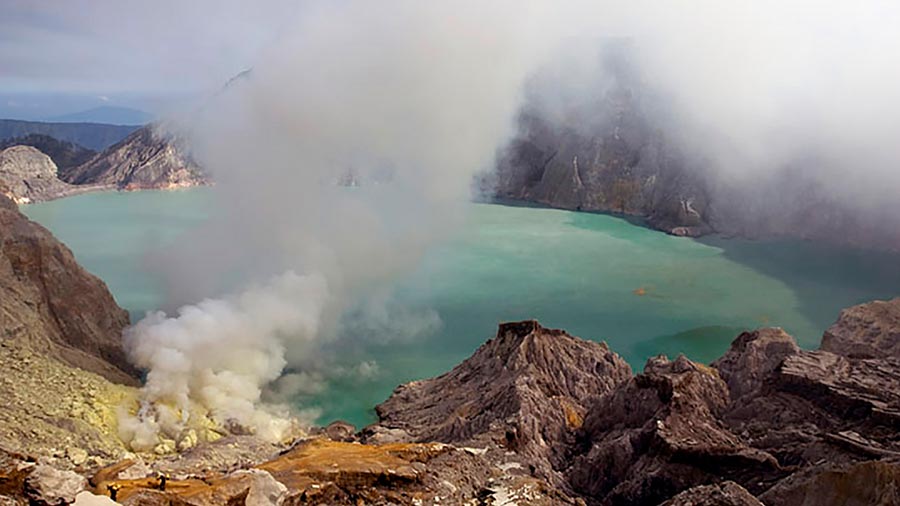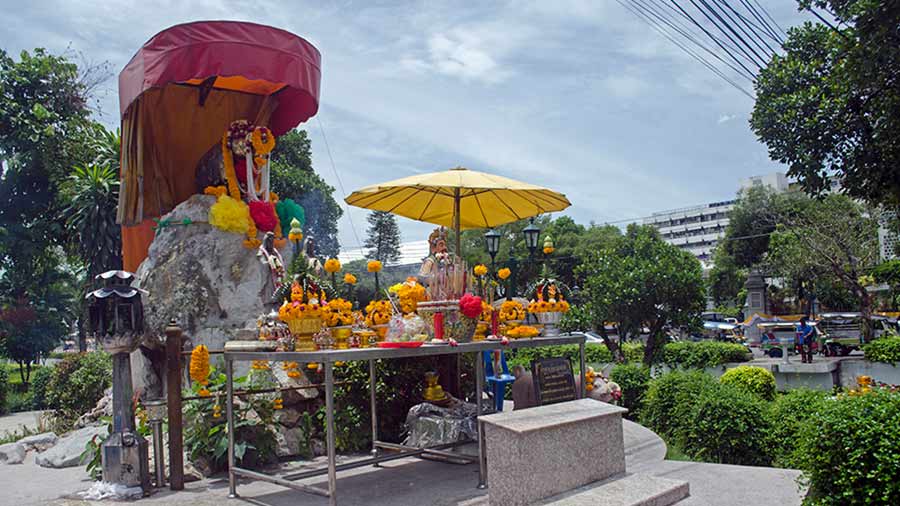I wake up with a start as the car comes to a sudden halt. My guide, Bang Bang, looks at me with a broad grin on his weather-beaten face. “Let’s have some tea and noodles,” he says, pointing to the dimly-lit cluster of three shanties. I look at my watch. It's 3.30am, and I don’t quite feel like having a meal at this hour.
“You will need it,” Bang Bang says firmly, and places the order for both of us. While sitting with my watery cup noodles, I watch a man finish his cup of tea, pick up a large pair of baskets, balance them carefully on his shoulders and stride into the inky oblivion that lies ahead of us.
“He is a sulphur miner,” Bang Bang informs me. “This is the first of his daily double-trip to the crater. He usually does this six days a week.”
A deadly occupation
A few minutes later, we begin our trek on a dirt road that winds steeply upward. It is an uphill trudge of more than 600 metres to our destination — the rim of the crater of Kawah Ijen, one of the active volcanoes of East Java in Indonesia. At the site is also a kilometre-wide acid lake that is the source of elemental sulphur mined manually by about 400 miners. In an age when sulphur is extracted mechanically in almost every other part of the world, Kawah Ijen remains the sole site of labour-intensive sulphur mining in the world. Here, miners hammer out a living enveloped in toxic sulphur fumes. As a result, the men who work here are more likely to succumb to lung diseases.
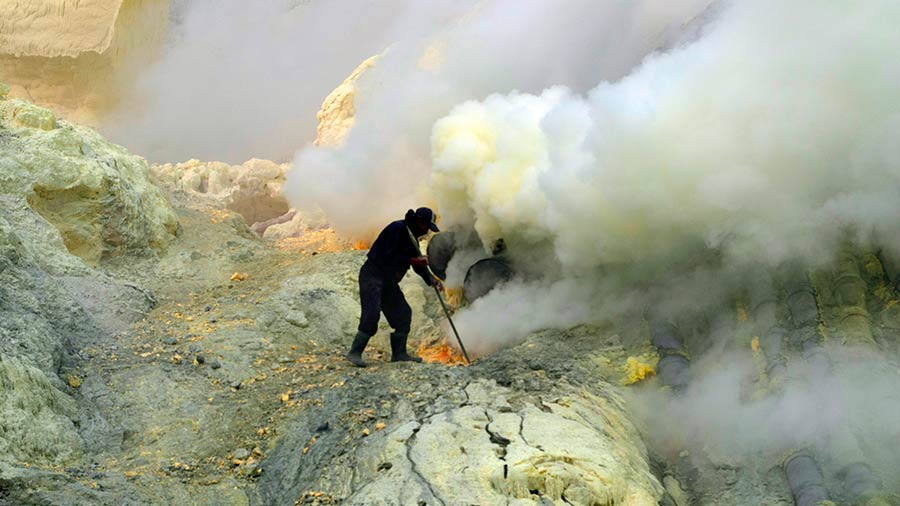
A miner breaks off sulphur chunks with his shovel as smoke jets out of the openings on the steaming slopes
As our trek continues, two shadowy figures jog past us in the darkness. I cannot make out their features, which are dimly lit by the glow of the cigarettes they are smoking, but I notice their skinny statures. Considering that these men, a few hours later, will be retracing this path lugging more than 70 kgs of sulphur chunks extracted from the crater, their bony physique shouldn’t be surprising.
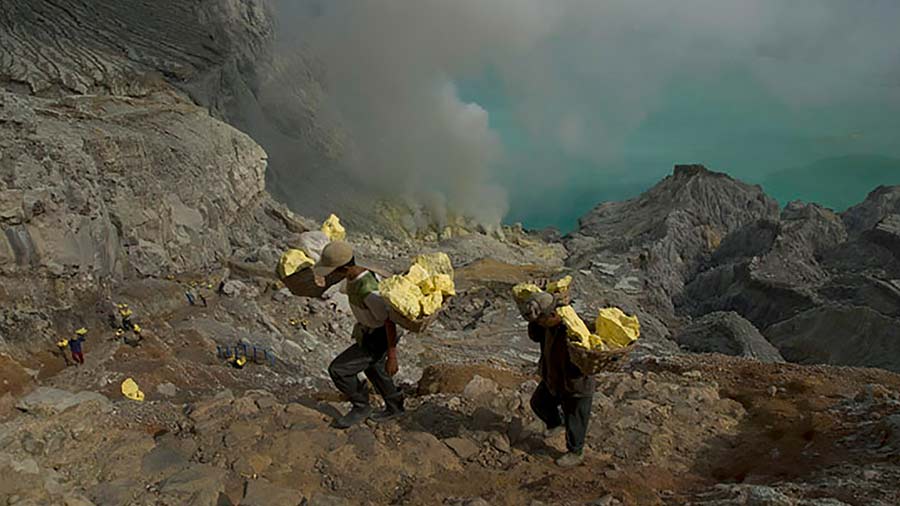
Miners lugging chunks of sulphur, a common sight in the areas surrounding the acid lake
“Their bodies have adapted to the harsh environment and the shoulder muscles have toughened with years of carrying those loads,” Bang Bang tells me, as more and more miners stride past us, hurrying up the steep gradient. The miners start their trips as early in the day as possible, as the heat becomes unbearable when the sun comes up.
The stench of rotten eggs
The trail becomes narrower and steeper, and Bang Bang warns me not to veer to my right as it is a sheer drop of several hundred feet. The vegetation changes too — stunted undergrowth take the place of the tall trees we were passing by till now. A gust of wind blows, and a strong, foul stench, like that of rotten eggs, wafts in, making my eyes water and nostrils burn. “Hydrogen sulphide,” Bang Bang says, and I quickly take out a scarf and cover my face.
The darkness slowly fades away, and the first rays of the rising sun filter through fluffy, pink clouds, illuminating the ochre ridge that takes the trekkers to the rim of the crater. The landscape is now barren and the wind has died down. Thankfully, the sulphurous smell is bearable.
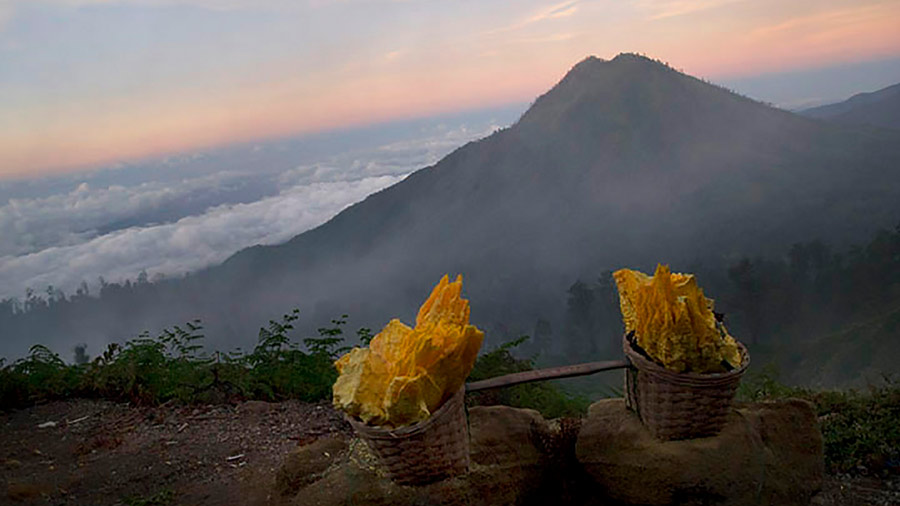
A pair of baskets containing extracted sulphur sit on a stony ledge, as dawn breaks over the mountain slopes
I meet Martha, a teacher from Rotterdam, at the edge of the rim. Here, a perpendicular trail drops into a smoky abyss and twirling sulphur fumes almost hide the murky green waters of the famous acid lake that sits at the bottom of the cavernous crater. “My husband has gone down about an hour ago, I hope he is still alive,” Martha quips in half jest, but her nervous smile betrays her anxiety. After all, the 1.2-km drop is nothing if not perilous — there are treacherous precipices, slippery steps and a toxic water body that claimed the life of a French tourist a few years back.
Treacherous trail
Bang Bang arrives with a small man of about 45. He is Padi, my guide for the trek down the crater. He has been working in the mines for about 20 years, and once in a while takes a day off to work as a guide for the odd tourists who want to go down to the bottom of the crater.
The next part of the journey begins. The rough trail drops straight down, and at times the gradient is so steep that I crouch down, balancing myself on the stony ledges on the sides.

The steep walls of stone that surround the lake, conquered daily by numerous miners to earn a living
The acrid smell of hydrogen sulphide intensifies and mingles with another pungent fume — sulphur dioxide. I pull on the gas mask Bang Bang had given me.
At a sharp turn, Padi asks me to wait. A long file of miners is slowly ascending from below, the mustard yellow chunks of sulphur in their baskets gleaming in the early morning light. Padi tells me that they usually take about an hour to reach from the lake to the rim but with more than 70 kgs of sulphur on their shoulders, this is amazingly fast. A man stops near me. I take out my pack of cigarettes and offer him one. He declines and points at my water bottle. As I hand him that, he takes a swig, smiles gratefully and resumes his upward grind.
The gradient eases near a stony outcrop that overlooks the mining area about 200 metres below. At this point, the scene resembles a hellish amphitheatre — greyish fumes billow from the steaming yellow hillside and a small squad of miners, in shoddy rubber boots and flip-flops, move in and out of that dense noxious smoke.

A miner walks away with his sulphur-laden baskets, while another enters the toxic fumes
Most of them have their faces covered with homespun scarves and a couple are working with no protective gear. In the last four decades, no less than 70 miners have died due to the sudden emission of highly concentrated poisonous gases from the rocky fissures. According to researchers, prolonged exposure to this toxic environment leaves the miners with an average life expectancy of a mere 45 years.
The descent continues, and another 20 minutes takes us to the bottom of the crater at the mining station. It is quarter past six, and as the mellow sunlight plays with the water, the Ijen lake turns into a mesmerising turquoise. The surreal beauty of the largest acidic lake on the planet often makes the visitors forget that the water here has a pH of 0.5, equivalent to battery acid. The fatal charm of the lake, however, is undeniable.
Mark of a miner
I begin retracing the vertical path away from the milky green lake, with a group of miners returning to the rim ahead of me. The man walking in front of me is bare-bodied, sweating profusely. As he swiftly switches the weight from one shoulder to the other, I get a glimpse of his shoulder muscles — a reddish-brown patch covers his burly back.
“Every miner has this mark,” Padi says casually. He removes his shirt collar to reveal a similar mark. “I don’t even feel the pain now,” Padi smiles as he puffs his clove cigarette.
We walk into a weighing station on our way down from the rim. A few miners are having a smoke before resuming their journey which will end at Pultuding, the roadhead. There, a truck will be waiting to take them to the sulphur factory a few kilometres away. The exhausted men heave off their load onto the weighing machine and watch carefully. They are paid the equivalent of Rs. 800 per kilogram of sulphur carried.
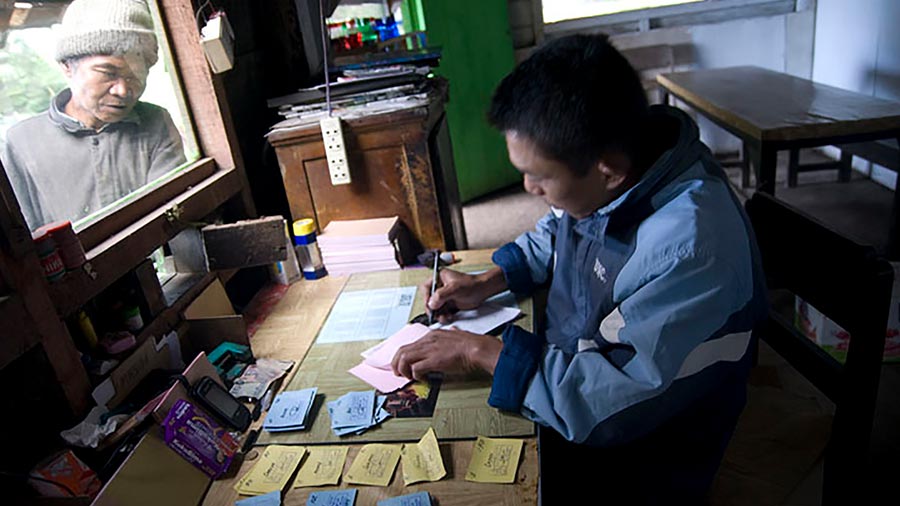
A clerk at the weighing station calculates the earnings for the sulphur collected, as a miner looks on
“So, for a double trip, a miner earns around $10 to $12 per day?” I ask Padi, after a quick mental calculation. By local standards, I gather, the money is not too bad, because a farmer in this country earns $5 a day.
“Yes, in exchange for poisoned lungs,” Padi says, grinning broadly at me. His good-humoured smile reveals his missing front teeth, lost as a result of the continuous exposure to noxious gases in his workplace. But I guess the miners have come to accept these losses as occupational hazards. After all, the Padis of the world never have a better choice waiting for them.
Sugato Mukherjee is a Kolkata-based photographer and writer whose work has appeared in The Globe and Mail, Al Jazeera and Nat Geo Traveller, among other places. He is the author of a coffee-table book on Ladakh and a book on the sulphur miners of East Java.
